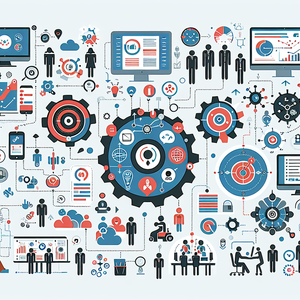Bioinformatics in the Age of AI: Salaries on the Rise

Bioinformatics operates at the intersection of biology, computer science, and statistics, focusing on the analysis and interpretation of complex biological data. With the emergence of AI technologies such as machine learning and natural language processing, bioinformatics has undergone a revolutionary change. Researchers can now analyze massive datasets—including genomic sequences, protein structures, and clinical data—much faster and more accurately than ever before. For example, machine learning algorithms can identify patterns in genetic data that would be nearly impossible for humans to discern, leading to breakthroughs in personalized medicine and drug discovery. Consequently, this shift has created new job roles requiring a blend of biological knowledge and technical prowess. Positions such as "AI Bioinformatics Scientist" and "Computational Biologist with AI Expertise" are becoming more prevalent, reflecting the growing importance of AI skills in the field.
Salary Trends Driven by AI Integration
The integration of AI in bioinformatics is markedly influencing salary structures across the industry. According to recent industry reports, professionals proficient in AI applications within bioinformatics can command salaries significantly higher than their peers in traditional roles. For instance, bioinformaticians skilled in machine learning and AI can earn between 20% to 30% more than those lacking these competencies. A survey by the International Society for Computational Biology found that bioinformaticians who are adept at using AI tools reported an average salary increase of 25% over the past two years. Many respondents attributed this rise to their involvement in high-impact projects that leverage AI for data analysis. Job postings increasingly emphasize the necessity of AI-related skills, demonstrating a clear market trend: professionals who can bridge bioinformatics and AI will enjoy lucrative career opportunities.
Future Job Market Projections
The future of bioinformatics, particularly in relation to AI, appears promising. The Bureau of Labor Statistics projects that the demand for bioinformatics professionals will grow by 31% over the next decade—significantly faster than the average for all occupations. As healthcare transitions toward more personalized and data-driven approaches, bioinformatics roles that incorporate AI will be critical in research, diagnostics, and therapeutic developments. Educational institutions are also responding to this trend by developing specialized programs that focus on the intersection of bioinformatics and AI. By equipping the next generation with the necessary skills, these programs prepare the workforce for the evolving landscape, further driving up salaries as competition for qualified candidates intensifies.
Supporting Examples
Several leading companies in biotechnology and pharmaceuticals are at the forefront of this trend. For instance, Illumina, a pioneer in genomic sequencing, has heavily invested in AI technologies to enhance their data analysis capabilities. As a result, they have experienced a significant increase in the demand for bioinformaticians skilled in AI, leading to competitive salary offerings and robust job growth. Another noteworthy example is Tempus, a technology company focused on precision medicine. By integrating AI into its bioinformatics processes, Tempus has made groundbreaking advancements in cancer treatment. The company actively seeks bioinformatics professionals with AI expertise, offering salaries that reflect the premium placed on these skills in today’s market.
The rise of AI is undeniably reshaping the landscape of bioinformatics, creating new opportunities, job roles, and higher salaries for professionals in the field. As organizations increasingly recognize the value of AI-driven insights in biological research and healthcare, the demand for skilled bioinformaticians will continue to grow. For those entering the field or contemplating a career shift, acquiring AI competencies will be essential for navigating this evolving job market and maximizing earning potential. The future is bright for bioinformatics professionals willing to embrace the intersection of biology and technology, marking an exciting era in this dynamic field.
AI Bioinformatics Scientist
Illumina, Tempus, Genentech
Responsibilities
Develop and implement machine learning algorithms to analyze large genomic datasets, identifying patterns and correlations critical to biological research.
Collaborate with interdisciplinary teams to design experiments and interpret AI-driven results in the context of biological questions.
Stay updated with the latest AI technologies and bioinformatics methodologies, integrating them into ongoing projects.
Required Skills
Proficiency in programming languages such as Python or R, with experience in machine learning libraries (e.g., TensorFlow, Scikit-learn).
Strong background in molecular biology and genetics, with a solid understanding of bioinformatics tools and databases.
Excellent analytical skills, capable of transforming complex data into actionable insights.
Computational Biologist with AI Expertise
Merck, GSK, Roche
Responsibilities
Utilize computational models and simulations to predict biological behavior and interactions, focusing on drug discovery and development.
Analyze high-throughput sequencing data to uncover insights that can inform clinical decisions and research directions.
Work closely with data scientists and biologists to refine algorithms and ensure relevance to biological applications.
Required Skills
Experience with statistical modeling and bioinformatics software (e.g., Bioconductor, Galaxy).
Familiarity with AI-driven approaches, including natural language processing for analyzing research literature.
Ability to communicate complex findings to non-technical stakeholders effectively.
Genomics Data Scientist
23andMe, Illumina, Tempus
Responsibilities
Analyze and interpret genomic data using AI and machine learning techniques to support personalized medicine initiatives.
Develop pipelines for processing and analyzing genomic datasets, ensuring data integrity and reproducibility.
Collaborate with clinical teams to integrate genomic findings into patient care protocols and treatment plans.
Required Skills
Advanced knowledge of genomic technologies and bioinformatics tools, including variant calling and annotation.
Proficiency in data manipulation and analysis using SQL, Python, or R.
Strong problem-solving skills, with a focus on translating data findings into clinical applications.
Bioinformatics Software Engineer
10x Genomics, Thermo Fisher Scientific, Bioinformatics startups
Responsibilities
Design and develop software applications for bioinformatics data analysis, integrating AI algorithms for enhanced functionality.
Collaborate with biologists and bioinformaticians to gather requirements and translate biological problems into software solutions.
Maintain and optimize existing bioinformatics tools, ensuring they are user-friendly and meet the needs of researchers.
Required Skills
Proficiency in software development languages such as Java, C++, or Python, with experience in cloud computing environments.
Understanding of bioinformatics concepts and data types, along with experience in developing APIs for data sharing.
Familiarity with agile methodologies and version control systems like Git.
Bioinformatics Analyst specializing in AI Applications
National Institutes of Health (NIH), Broad Institute, academic research institutions
Responsibilities
Conduct exploratory data analysis on biological datasets using AI techniques to uncover key insights and trends.
Prepare and present reports on findings, contributing to research publications and grant proposals.
Work closely with database managers to ensure data is properly curated and accessible for analysis.
Required Skills
Strong skills in data visualization tools (e.g., Tableau, Matplotlib) and experience in scripting for data analysis.
Knowledge of machine learning algorithms and their applications in bioinformatics, including supervised and unsupervised learning techniques.
Ability to work collaboratively in a team-oriented environment while managing multiple projects.


